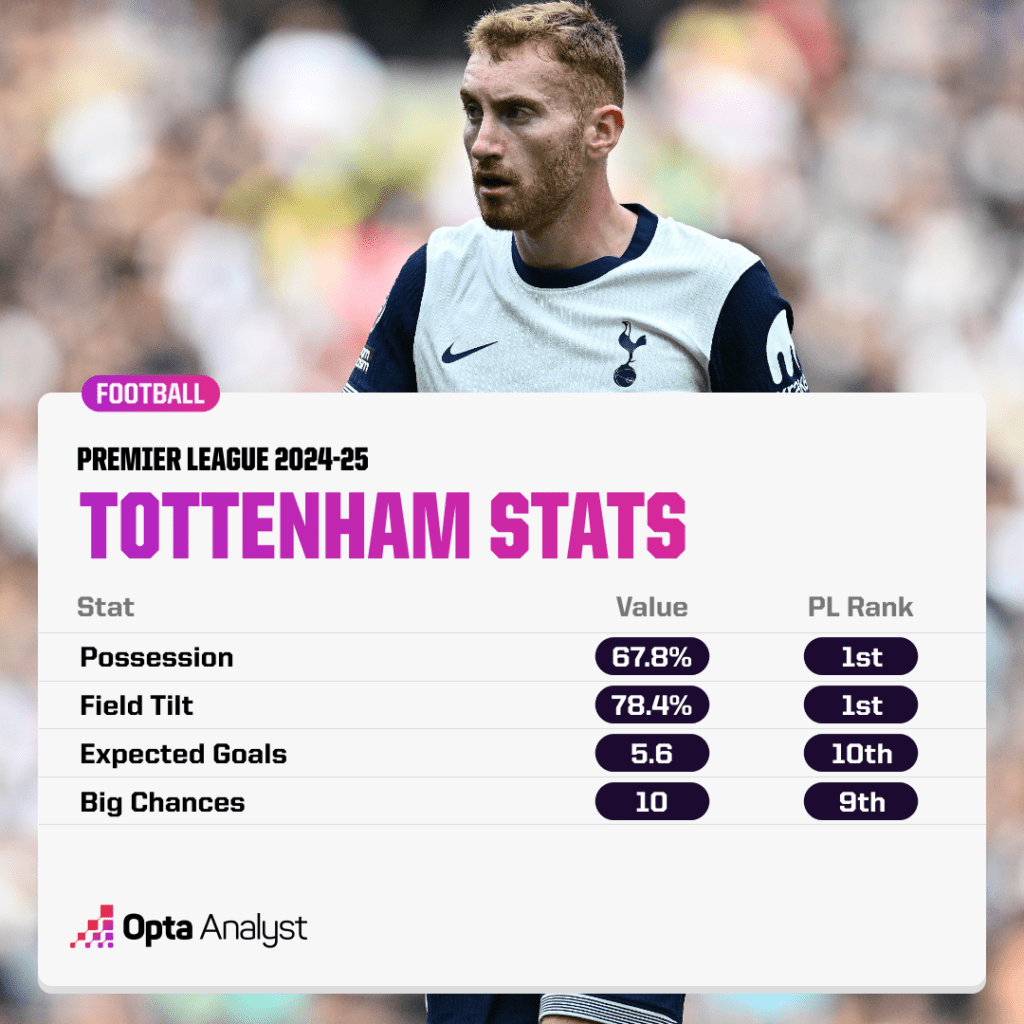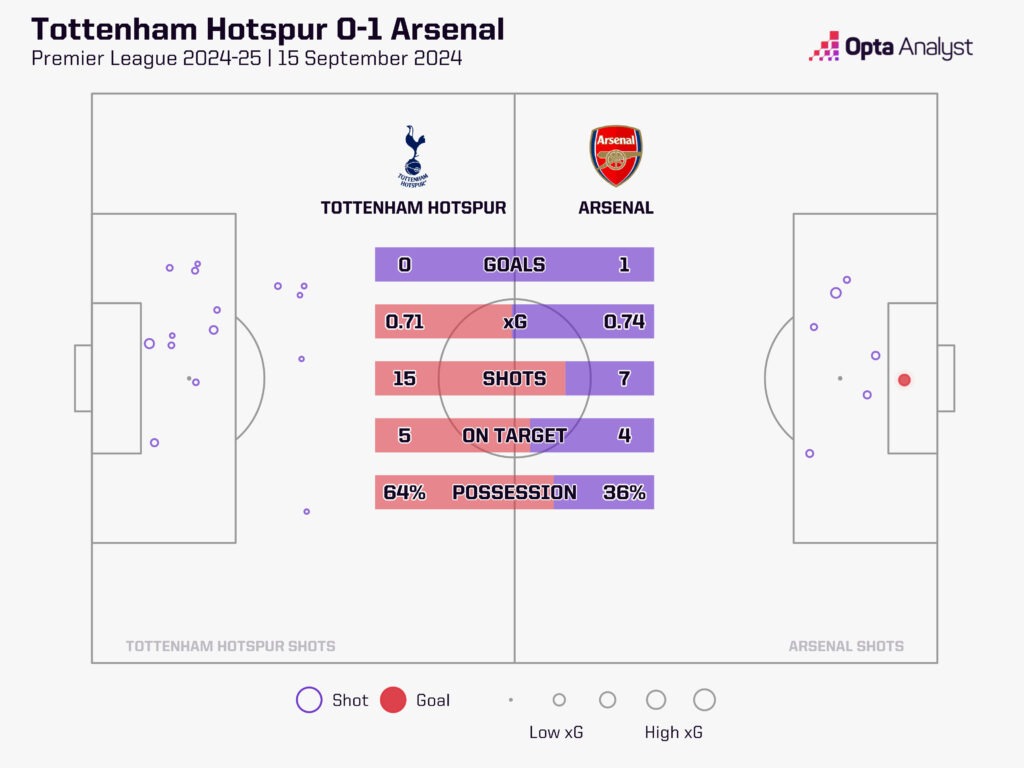Possession and Territory, but Too Few Chances Created ...
Tottenham are seeing more of the ball than any other Premier League team this season, but they’re not forging many clear sights of goal. We look at the numbers behind their struggles.

Among plenty of positives during Ange Postecoglou’s Tottenham reign, there have been a few specific issues that have plagued his team.
Most of them have involved trying – or more accurately, failing – to keep the ball out of their own net.
A running theme has been their weakness at defensive set-pieces – something that was once again their downfall in Sunday’s north London derby defeat to Arsenal.
Then there is the height of their defensive line. “Suicidal” is a word that has been used to describe it by some watchers, given just how bold their high-line approach has been. Spurs have conceded a lot of chances as a result of opponents exploiting the space in behind their defenders, and plenty more potential opportunities have been prevented only by Micky van de Ven’s lightning-quick recovery runs. It was that high line and the space in behind that Newcastle exploited to score the winner in the recent meeting at St James’ Park.
Taking an optimistic view of their start to the season, though, you could argue it’s a positive that those are the only two times Spurs’ biggest issues have led to goals being conceded. In last season’s home match against Arsenal, for example, Spurs let in two goals from corners and one on the break. Defensively, it appears there has been some improvement, though clearly still not quite enough.
However, another issue has arisen – this time at the other end of the pitch. Spurs are struggling terribly to turn their possession and territory, both of which they are having a lot of, into goals and results.
Postecoglou’s men have averaged 67.8% possession in Premier League games this season, more than five percentage points higher than anyone else, with Manchester City second on 62.1%.
We can use a metric called field tilt to show that Spurs are playing their football higher up the pitch than everyone else, too. Field tilt measures territorial dominance between teams, looking at the share of possession each side has in their attacking third compared to their opponent. A field tilt of over 50% means your team makes more passes in the opposition’s final third than they make in your defensive third. Spurs’ field tilt of 78.4% is the highest in the Premier League this season, again ahead of Manchester City in second place.
In their four matches, Tottenham have produced four of the 14 highest field-tilt rates by any team in a Premier League game this season, as well as four of the 14 highest possession shares. They are dominating the ball all over the pitch.
They have scored six goals in four games, but four of them came against Everton, who put in a woeful display at the Tottenham Hotspur Stadium on Matchday 2. Two goals in three games against Leicester City, Newcastle and Arsenal – games from which Tottenham took just one point – has left them 13th in the table, five points off the top four and already playing catch-up.
The problem hasn’t just been scoring goals. Anyone watching Spurs will tell you they have struggled to create good goalscoring opportunities despite seeing so much of the ball, the Everton game aside.

The numbers back up the eye test, too.
We can look at the number of times Spurs enter attacking parts of the pitch and the number of chances they create – as well as the quality of those chances – to show just how ineffective and inefficient they’ve been with the ball.
Tottenham are averaging 0.018 expected goals for every time they move the ball (either with a pass or a player carrying it) into the final third of the pitch in Premier League games this season. Only the three promoted sides and Everton – currently enduring their worst start to a league season since the 1950s – are producing lower numbers for every final-third entry.
But Tottenham are spending longer periods in the final third than those teams; rather than entering the attacking third of the pitch time and again (and racking up lots of final-third entries), we have seen them camped deep in opposition territory, moving the ball about within the final third for a long time.
It is more telling, therefore, to look at how often they have got the ball into the opposition’s penalty area; they have done so with a pass or carry more times this season than any other Premier League team, 198 times in their four games – an average of 49.5 times per game. In other words, they are getting into the penalty area more than once every two minutes, which – alone at least – is a hugely impressive rate.
But the final ball, the final movement to create a big chance is letting them down terribly.
Spurs are averaging 0.32 shots for every occasion that they enter the opposition’s penalty area – the lowest rate of all teams in the top flight this season. Meanwhile, only Ipswich (0.025), have generated a lower xG value for every penalty-area entry than Tottenham (0.028 xG). Put another way, Spurs are creating chances relative to the positions they are getting into less efficiently than every team bar Ipswich, who have only just come up from the Championship and have already faced both Liverpool and Manchester City.
Another way of looking at Spurs’ xG per penalty-area entry of 0.028 is that it means they need 35.4 penalty-area entries to generate 1.0 xG. In other words, they need to move the ball into the penalty area more than 35 times just to create enough chances for them to be expected to score one goal. For comparison, Manchester United need 16 penalty-area entries this season to generate 1.0 xG; Chelsea need 17.6; Aston Villa need 17.9 and Newcastle need 21.6. Those are the teams Spurs are likely to be chasing Champions League football with come May.
Given Spurs are scoring almost exactly in line with their expected goals, they are requiring a hell of a lot of territory and possession to produce each of their goals. And their numbers are skewed massively by the Everton result, too.
At the same time, they shouldn’t be criticised too much for how much they struggled against Arsenal. Mikel Arteta brought his weakened side across north London with the aim of frustrating their rivals and digging in for a clean sheet.
With defensive midfielders Jorginho and Thomas Partey parked in front of the defence, the visitors were content to let Tottenham have the ball, and they made themselves incredibly difficult to play through. They managed the game brilliantly and Spurs just could not find any rhythm.
But there did appear to be a lack of ambition in Tottenham’s attacking play; an unwillingness to take risks. On numerous occasions, their best players turned down a chance to take the ball on the half-turn into a gap or run at their direct opponent.
Arsenal have exceptional individual defenders – players who don’t get beaten in duels very often at all – so maybe Postecoglou told his attackers to be a bit more cautious on the ball, but every time one of them slowed down the attack, they allowed Arsenal to get back into their impenetrable shape.
Spurs attempted 21 dribbles to Arsenal’s 20, despite having 63.7% possession. Their five most attacking starters attempted just 13 dribbles, while Arsenal’s front four attempted 16. The game was better set up for Arsenal’s players to run and take opponents on, but given how much of the ball Spurs’ players saw, they surely should have taken more chances to try and beat their man.
Postecoglou has built a squad with lots of pace in the front three; runners who can get in down the flanks and put balls across the face of goal for a simple finish. Last season, we saw the archetypal Ange-ball goal scored time and again.
But this season, opponents have decided to make more effort to restrict the space in behind their defence for Spurs to attack and, so far, it doesn’t look like they have a solution to that puzzle.
James Maddison is one player with the talent to unlock a set defence, but he hasn’t been at his best since the ankle injury he picked up in that Chelsea game last November. Postecoglou could do with his midfielder rediscovering his best form.
But while that would naturally help matters, this issue can’t be solved by any individual. Tottenham’s manager needs to give his players the confidence to take more risks, to be willing to receive the ball on the half-turn in tight spaces and to try more things that might not come off. And he needs to work on making sure his team take advantage of any space the opposition afford them.
Much more possession without penetration, and patience might just start to wear thin.
Subscribe to our football newsletter to receive exclusive weekly content. You should also follow our social accounts over on X, Instagram, TikTok and Facebook.









































